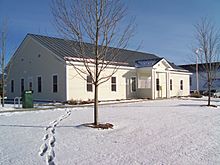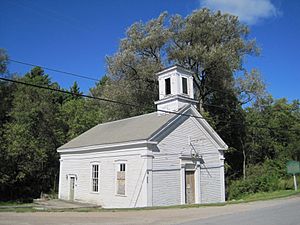New Haven, Vermont facts for kids
Quick facts for kids
New Haven, Vermont
|
|
|---|---|

town offices and library
|
|

Location in Addison County and the state of Vermont.
|
|
| Country | United States |
| State | Vermont |
| County | Addison |
| Communities | New Haven New Haven Junction New Haven Mills Brooksville |
| Area | |
| • Total | 41.5 sq mi (107.6 km2) |
| • Land | 41.2 sq mi (106.7 km2) |
| • Water | 0.3 sq mi (0.9 km2) |
| Elevation | 341 ft (104 m) |
| Population
(2020)
|
|
| • Total | 1,683 |
| • Density | 41/sq mi (15.8/km2) |
| Time zone | UTC-5 (Eastern (EST)) |
| • Summer (DST) | UTC-4 (EDT) |
| ZIP code |
05472
|
| Area code | 802 |
| FIPS code | 50-48700 |
| GNIS feature ID | 1462160 |
New Haven is a small town located in Addison County, Vermont, in the United States. In 2020, about 1,683 people lived there. The town includes several smaller communities like Belden, Brooksville, New Haven Junction, and New Haven Mills. It's a quiet place in the beautiful state of Vermont.
Contents
Exploring New Haven's Location
New Haven is found in the northern part of Addison County. It sits in an area called the Champlain Valley. The town shares its borders with several other towns. To the north are Ferrisburgh and Monkton. Bristol is to the east, and Middlebury is to the south.
Rivers and Waterways
Otter Creek is one of Vermont's longest rivers. It forms part of New Haven's southwestern border. You can find waterfalls there at Belden and Huntington Falls. The New Haven River flows from the Green Mountains into Otter Creek at Brooksville.
Roads and Travel
U.S. Route 7 is a main road that goes through New Haven. It connects the towns of Vergennes and Middlebury. Another important road is Vermont Route 17. It crosses Route 7 at New Haven Junction. Route 17 goes east to Bristol and west towards Lake Champlain.
Land and Water Area
New Haven covers a total area of about 107.6 square kilometers (41.5 square miles). Most of this area is land, around 106.7 square kilometers (41.2 square miles). A small part, about 0.9 square kilometers (0.3 square miles), is water.
New Haven's Population Over Time
| Historical population | |||
|---|---|---|---|
| Census | Pop. | %± | |
| 1790 | 723 | — | |
| 1800 | 1,135 | 57.0% | |
| 1810 | 1,688 | 48.7% | |
| 1820 | 1,566 | −7.2% | |
| 1830 | 1,834 | 17.1% | |
| 1840 | 1,503 | −18.0% | |
| 1850 | 1,663 | 10.6% | |
| 1860 | 1,419 | −14.7% | |
| 1870 | 1,355 | −4.5% | |
| 1880 | 1,355 | 0.0% | |
| 1890 | 1,224 | −9.7% | |
| 1900 | 1,107 | −9.6% | |
| 1910 | 1,161 | 4.9% | |
| 1920 | 1,001 | −13.8% | |
| 1930 | 964 | −3.7% | |
| 1940 | 881 | −8.6% | |
| 1950 | 932 | 5.8% | |
| 1960 | 922 | −1.1% | |
| 1970 | 1,039 | 12.7% | |
| 1980 | 1,217 | 17.1% | |
| 1990 | 1,375 | 13.0% | |
| 2000 | 1,666 | 21.2% | |
| 2010 | 1,727 | 3.7% | |
| 2020 | 1,683 | −2.5% | |
| U.S. Decennial Census | |||
In 2000, there were 1,666 people living in New Haven. These people lived in 613 homes. Most of the people were White (98.26%). A small number were African American or Native American. Some people were of Hispanic or Latino background.
Family Life in New Haven
Many homes in New Haven had children under 18 living there (37.4%). Most homes were made up of married couples. The average household had about 2.72 people. The average family had about 3.09 people.
Age Groups in Town
About 27% of the people in New Haven were under 18 years old. About 9.5% were 65 years or older. The average age of people in the town was 38 years old.
Famous People from New Haven
New Haven has been home to several notable individuals. These people have made important contributions in different fields.
- Christopher A. Bray - He has served in the Vermont House of Representatives and the Vermont Senate.
- Josiah Bushnell Grinnell - He founded the town of Grinnell, Iowa. He also helped start Grinnell College.
- Homer Hulbert - He was a missionary who worked for Korean independence.
- Curtis M. Lampson - He was a fur merchant. He is known for helping to promote the first transatlantic telegraph cable.
- Robert Bruce Langdon - He was a businessman and a Minnesota State Senator.
- Royal T. Sprague - He was the 11th Chief Justice of the Supreme Court of California.
- Allen R. Sturtevant - He was an Associate Justice of the Vermont Supreme Court.
See also
 In Spanish: New Haven (Vermont) para niños
In Spanish: New Haven (Vermont) para niños


